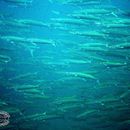Diagnostic Description
provided by Fishbase
Many dark bars crossing lateral line on body, each bar oblique in upper half, but nearly vertical in the lower; caudal fin largely blackish. No gill rakers on first arch; upper and lower gill arch with rough platelets, each platelet not bearing distinct spine.Description: Characterized further by silvery body color; black margin on caudal fin; forked caudal fin with distinct, inner lobe on each side of middle of fin; erect and close-set teeth; corner of preopercle lacking projecting membranous flap; maxilla reaching below or slightly beyond anterior edge of eye; moderate sized eye; first dorsal origin over rear base of pelvic fins; depth of body 6.0-7.9 in SL (Ref. 90102).
- Recorder
- Cristina V. Garilao
Life Cycle
provided by Fishbase
In general, barracudas in large numbers aggegate during spawning season and migrate to specific spawning areas (Ref. 240).
Morphology
provided by Fishbase
Dorsal spines (total): 6; Dorsal soft rays (total): 9; Analspines: 2; Analsoft rays: 7 - 9
- Recorder
- Cristina V. Garilao
Trophic Strategy
provided by Fishbase
Found near current-swept lagoon and seaward reefs (Ref. 9710). Usually seen in large semi-stationary schools during the day (Ref. 9768) which have a tendency to occupy the same site for months or even years at a time. Probably disperses at night to feed (Ref. 1602). Often hooked by trolling between dusk and dawn (Ref. 37816).
Biology
provided by Fishbase
Found near current-swept lagoon and seaward reefs (Ref. 9710). Feeds on fishes (Ref. 89972). Usually seen in large semi-stationary schools during the day (Ref. 9768) which have a tendency to occupy the same site for months or even years at a time. Probably disperses at night to feed (Ref. 1602). Often hooked by trolling between dusk and dawn (Ref. 37816).
Importance
provided by Fishbase
fisheries: commercial; gamefish: yes
分布
provided by The Fish Database of Taiwan
廣泛分布於印度-太平洋區,由紅海、非洲東南部至墨西哥、巴拿馬,北至日本南部,南至新加勒多尼亞。台灣四周海域亦均有產。
利用
provided by The Fish Database of Taiwan
漁期全年皆有,可利用定置網、流刺網、拖曳釣等漁法捕獲,肉味鮮美,適宜油煎、紅燒、煮薑絲湯等。
描述
provided by The Fish Database of Taiwan
體延長,略側扁,呈亞圓柱形。頭長而吻尖突。口裂大,寬平;下頜突出於上頜;上頜骨末端及眼前緣之下方;上下頜及腭骨均具尖銳且大小不一之犬狀齒,鋤骨無齒。無鰓耙。體被小圓鱗;側線鱗數120-130。具兩個背鰭,彼此分離甚遠;第二背鰭末端不延長;腹鰭起點位於背鰭起點之前;胸鰭略短,末端幾達背鰭起點之下方;尾鰭於幼魚時為深叉形,成魚呈雙凹形。體背部呈青灰藍色,腹部呈白色;體側具許多延伸至腹部之暗色橫帶,上半部橫帶傾斜,下半部則幾垂直。尾鰭一致為暗色;餘鰭皆為灰黑色。以前所記載之黑鰭金梭魚(/S.
nigripinnis/)為本種之同種異名。
棲地
provided by The Fish Database of Taiwan
主要棲息於大洋較近岸的礁區、內灣、潟湖區或河口域,常成大群數一起於日間活動。游泳能力強,活動範圍廣,並無固定的棲所。肉食性,以礁區的魚類及頭足類為食。
Blackfin barracuda
provided by wikipedia EN
The blackfin barracuda (Sphyraena qenie), also known as the chevron barracuda, is a species of barracuda that ranges from the Red Sea and East Africa to the Indo and Western Pacific and as far as French Polynesia.
The blackfin barracuda reaches a maximum size of 140 cm. They are typically encountered on coral reefs down to 50 m where they form large schools.[1][2][3][4] The Blackfin barracuda are known for their long black lateral bands that go around its body. There are about 18 to 22 bands that are on the fish's body. They have elongated last rays on the second dorsal fin and anal fins and a blackish caudal fin (tail fin). They lack gill rakers.[5]
References
-
^ Froese, Rainer; Pauly, Daniel (eds.) (2014). "Sphyraena qenie" in FishBase. February 2014 version.
-
^ WoRMS - World Register of Marine Species - Sphyraena qenie Klunzinger, 1870
-
^ Lieske, Ewald; Myers, Robert (2004). Coral reef guide. Red Sea. p. 207. ISBN 9780007741731.
-
^ Allen, Gerald; Erdmann, Mark (2013). Reef Fishes of the East Indies - Volume III.
-
^ Morishita, S. (2020). Morphological comparisons of Sphyraena qenie with S. putnamae, with a revised key to Indo-Pacific species of Sphyraena lacking gill rakers (Sphyraenidae). Ichthyological Research, 67(3), 456–463. https://doi.org/10.1007/s10228-020-00738-6

- license
- cc-by-sa-3.0
- copyright
- Wikipedia authors and editors
Blackfin barracuda: Brief Summary
provided by wikipedia EN
The blackfin barracuda (Sphyraena qenie), also known as the chevron barracuda, is a species of barracuda that ranges from the Red Sea and East Africa to the Indo and Western Pacific and as far as French Polynesia.
The blackfin barracuda reaches a maximum size of 140 cm. They are typically encountered on coral reefs down to 50 m where they form large schools. The Blackfin barracuda are known for their long black lateral bands that go around its body. There are about 18 to 22 bands that are on the fish's body. They have elongated last rays on the second dorsal fin and anal fins and a blackish caudal fin (tail fin). They lack gill rakers.
- license
- cc-by-sa-3.0
- copyright
- Wikipedia authors and editors
Description
provided by World Register of Marine Species
Inhabits clear waters near coral reefs (Ref. 9768). Usually seen in large semistationary schools during the day (Ref. 9768).
Froese, R. & D. Pauly (Editors). (2023). FishBase. World Wide Web electronic publication. version (02/2023).
- license
- cc-by-4.0
- copyright
- WoRMS Editorial Board

